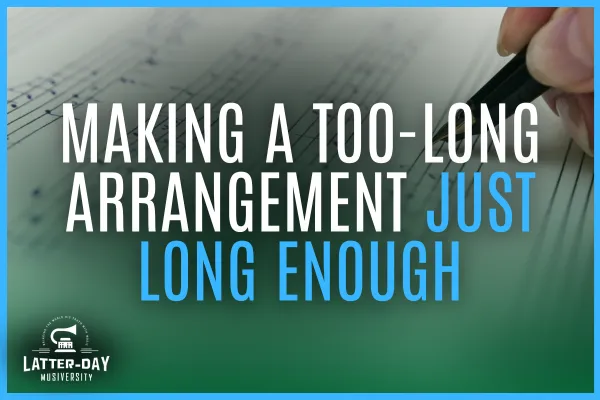
Making a Too-Long Arrangement Just Long Enough
Today I'm sharing two final arranging tips from the choral version of "Behold the Wounds in Jesus' Hands."
As I promised in the last post, I'm first going to share another tip about how to make a 4-verse arrangement feel NOT too long.
This first tip has to do with making the melody... which has now been presented 4 times... and which is in serious danger of becoming redundant in so many hearings without any contrasting sections... wonderful and just the right way to finish.
The final verse of the piece is a half-step higher, thanks to a pretty direct modulation (my least favorite part of the piece—but the rest is so good, so I decided not to comment on it).
This 4th verse begins with a nice big organ sound and a powerful unison from the choir, giving them the loudest possible volume a choir can achieve.
This continues for the first half of the verse.
But then, as the 2nd half of the verse continues, the voices split into 4, and even a little bit of 5-part harmony.
As you can see in the blue highlights below, the sopranos no longer sing the melody. They are singing a descant as the altos carry the melody.
GO ALTOS!!
And to add to the intensity-adding descant, the sopranos get 4 notes of what is sort of a double descant.
It's a pretty satisfying start to this culminating phrase.
Personally, I would have voiced 2 of these chords a little differently, as you can see in red below.
But, these are very minor issues. I think they balance the sound of the choir a little better. But, we can talk more about that another day.
But for me, this is not yet the most interesting and climactic part of this final verse.
What I find particularly meaningful is...
...what happens, beginning with the pick-up to bar 74.
Rather than end the melody of this 4th verse with the same notes and intervals of every other verse...
...the sopranos take us on a new melodic path to the final E-flat.
Bars 74 and 75 are a melodic outdoing, or culminating development on the end of the tune.
I absolutely LOVE it when long melodies do this.
It's the composer using a great deal of patience, holding onto something special for the LAST time through.
It seems like such a simple principle.
But it's done FAR too little in our standard Sacrament Meeting music.
And now, for the final point today... the magical moment in the coda.
As you can see in bars 74 and 75, the 2 bars both begin with a C... which happens to be the 6th scale degree in the key of E-flat major.
When the Coda begins at the pickup to letter I (see below), the choir, in unison, returns to this 6th scale degree C.
It's a lovely, yearning kind of feel to the opening of the Coda.
But what tops it off is...
After stepping down to the G on beat 4, we leap up to the MOST potent of all scale degrees in any major key...
The 7th scale degree...
Otherwise known as the Leading Tone.
And with this D Leading Tone on the downbeat, and the stepping down afterwards...
It leaves that big upward leap of a 5th...
A very pleading, yearning, emotional kind of leap, especially when landing on the 7th scale degree...
Hanging in the air.
The D MUST be resolved.
We can't end with it hanging in the air.
But, instead of ending with a big heroic high E-flat...
The Coda melody falls down, resolving quietly, tenderly, like a 1-on-1, introspective, personal resolution into the open arms of our personal Savior.
What a wonderful ending!
These are tips you'll want to hold onto.
They work VERY well.
And can be used in MANY different contexts.
Perhaps they would be JUST the thing for your arrangement in the upcoming 14-Day Hymn Arrangement Challenge.
To be sure you don't miss all the fun of the upcoming challenge... or the extra special goodies for everyone who put their name on the waiting list...
Click here to add your name now.
Oh, and if you'd like to listen to this final section of Behold the Wounds, you can do so here:
(Example starts at the 4:25 mark)
I hope you've enjoyed this deeper look into this lovely piece.
Doug "save something special for the end" Pew